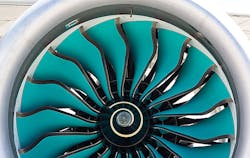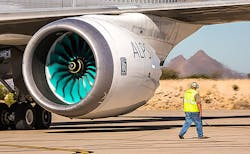Rolls Plans Center for Carbon-Fiber Composite Fan Blades, Cases
Rolls-Royce Plc plans to establish a research center for developing carbon-fiber composite materials technologies for fan blades and fan cases, to be in operation by late 2019. The operation will be in Bristol, England, described as a “pre-production facility” and employing 120 persons, will develop products and technologies that will be applied to the OEM’s emerging turbofan engine series.
“This is the latest example of Rolls-Royce’s commitment to investing in innovative technology and world-class facilities to improve performance and drive profitable growth for our business,” stated Rolls-Royce’s Tony Wood, president – Aerospace.
Wood emphasized that the “high-technology lightweight components have the potential to significantly improve the fuel consumption and emissions of future aircraft through our new Rolls-Royce Advance and UltraFan™ demonstrators.”
Last year Rolls-Royce introduced the two new engine designs that are intended to be commercially available in the next decade, offering reduced fuel burn and CO2 emissions than current standard jet engines. The group’s current standard for commercial jets is its Trent series high-bypass turbofan engines, in particular the Trent XWB used to power the new Airbus A350 wide-body aircraft.
The new Advance engine would be introduced by 2020, offering at least 20% more fuel-efficiency and comparable reductions in CO2 emissions than the first generation of Trent engines.
The UltraFan™ engine will introduce geared turbofan technology to the Rolls-Royce portfolio. Rolls stated last year that the UltraFan would come to market in 2025, and will provide at least 25% more fuel-efficiency and similarly lower emissions levels.
For Rolls-Royce, carbon/titanium (CTi) blades are a critical feature of the Advance engine design. The blades and associated composite engine casings would help to reduce the weight of the engines by up to 1,500 lb/aircraft. It described this weight savings as “the equivalent of carrying seven more passengers and their luggage.”
Carbon-fiber composites are increasingly used by aerospace designers to achieve weight reductions in aircraft, to lower fuel consumption and reduce emissions. Rolls-Royce has been developing carbon-fiber technologies for more than 20 years and uses the material to form numerous component parts for itss aero engines. In addition, it has developed a range of automated technologies for producing composite fan blades and fan casings.
The new research center in Bristol will be developed alongside Rolls-Royce’s new operation for carbon-fiber electrical harness rafts. It noted that both new operation would benefit from manufacturing techniques being developed in partnership with the National Composites Centre in Bristol, and research underway at the Rolls-Royce University Technology Centre at the University of Bristol.
Rolls-Royce’s CTi manufacturing technology capability and about 40 employees will be transferred from a composites manufacturing center on the Isle of Wight during 2017, meaning up to 80 new positions might could be established in Bristol in the coming years. The U.K. government provided £7.4 million to support the establishment of the pre-production facility and equipment at the Isle of Wight facility, and these will be developed further at the new center in Bristol.
Carbon-fiber composites are predominantly used in the aerospace industry to enable significant reduction in weight, leading to lower fuel consumption and reduced emissions. Rolls-Royce has been involved in developing carbon-fiber technologies for several decades and already uses the material for a number of parts within its aero engines. Innovative automated methods have been developed specifically for producing composite fan blades and fan casings.
About the Author
Robert Brooks
Content Director
Robert Brooks has been a business-to-business reporter, writer, editor, and columnist for more than 20 years, specializing in the primary metal and basic manufacturing industries.

